Winter in California not only brings cooler temperatures and occasional rain but also heralds the arrival of numerous bird species from their breeding grounds in northern regions.
As other parts of the country are blanketed in snow, California remains a favorable wintering habitat for various avian visitors.
From majestic raptors and colorful songbirds to charismatic waterfowl and elusive shorebirds, the state’s geographical features and mild climate create an inviting environment for these migratory birds.
This introduction will delve into the fascinating world of winter birds in California, highlighting their unique adaptations, behaviors, and conservation efforts undertaken to protect these winged wonders.
45 Winter Birds In California
As you might encounter during the colder months in this beautiful state, California is home to many bird species, many of which can be spotted during winter.
Here’s a list of 45 winter birds commonly found in California:
1. Anna’s Hummingbird
Anna’s hummingbird is a type of hummingbird found in North America. It received its name from Anna Masséna, the Duchess of Rivoli. This hummingbird species is primarily found in the western coastal regions of North America.
During the early 20th century, Anna’s hummingbirds were only known to breed in two specific areas: northern Baja California and Southern California. These regions were their native habitats and not commonly found elsewhere.
The specific locations where Anna’s hummingbirds bred were important for their survival and reproductive success. The birds needed suitable environments in these regions to build their nests and raise their young.
The hummingbirds’ preference for breeding in northern Baja California and Southern California may have been influenced by climate, availability of food sources, and suitable vegetation for nesting.
These regions likely provided the necessary resources and conditions for their survival. It is interesting to note that Anna’s hummingbirds were not widespread throughout North America during this time.
They were limited to these specific coastal areas, contributing to their uniqueness and significance within the hummingbird species. As time passed and habitats changed, the distribution of Anna’s hummingbirds may have expanded beyond their original breeding areas.
| Kingdom | Animalia |
| Phylum | Chordata |
| Clade | Strisores |
| Class | Aves |
| Order | Apodiformes |
| Family | Trochilidae |
| Genus | Calypte |
| Species | C. anna |
2. House Finch
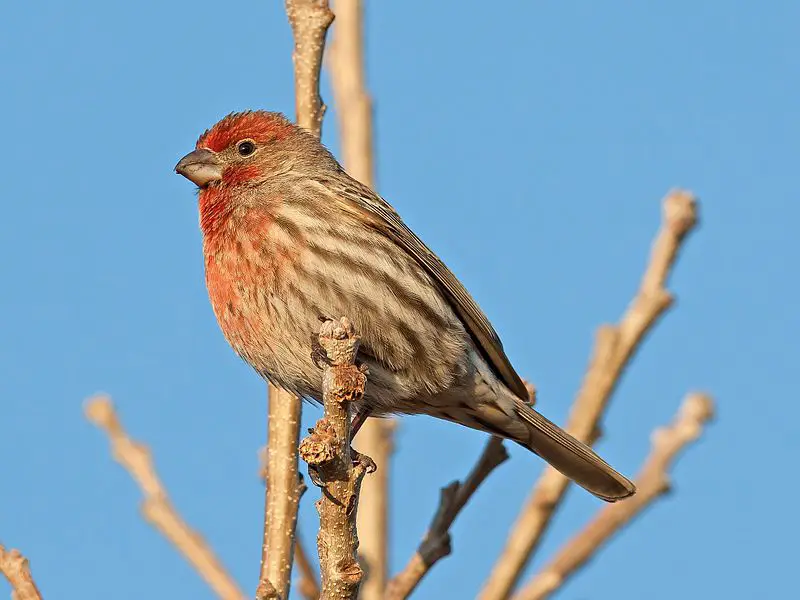
The house finch is a type of bird that belongs to the finch family called Fringillidae. This bird is originally from western North America.
However, it has also been introduced to other parts of the continent, such as the eastern half and Hawaii. The house finch is not the only bird in its genus.
It is grouped with two other American rosefinches, and all three are placed in the genus Haemorhous. The house finch is known for its beautiful red coloration, especially in males. The males have a reddish hue on their heads, chests, and backs.
Females, on the other hand, have more muted colors with brownish feathers. These birds are relatively small, measuring about 12 to 16 centimeters in length. They have short wings and a slightly notched tail.
Their beaks are conical in shape and designed for cracking open seeds, their primary food source. House finches are highly adaptable and can be found in various habitats, including urban areas, forests, and grasslands.
They are known for their melodic songs, which they use to communicate and attract mates. Breeding season for these.
| Kingdom | Animalia |
| Phylum | Chordata |
| Clade | Dinosauria |
| Class | Aves |
| Order | Passeriformes |
| Family | Fringillidae |
| Genus | Haemorhous |
| Species | H. mexicanus |
3. California Scrub Jay
The California scrub jay is a type of bird called a scrub jay. It is found in western North America. This bird species can be seen in many places, such as southern British Columbia, California, and western Nevada near Reno.
The California scrub jay also lives in areas on the western side of the Sierra Nevada mountain range. This bird is specifically known as the California scrub jay because it is native to California.
It is well adapted to the habitat and environment found in this region.
The California scrub jay has certain characteristics and behaviors that help it survive and thrive in its natural surroundings. The range of the California scrub jay extends from southern British Columbia to western Nevada.
This means that this bird can be found in a wide geographic area. It covers a large portion of the western part of North America.
The California scrub jay can inhabit various habitats within this range, such as forests, woodlands, and gardens. One interesting fact about the California scrub jay is that it is a member of the corvid family, which includes other intelligent birds like crows and ravens.
The California scrub jay is known for its cleverness and problem-solving abilities.
| Kingdom | Animalia |
| Phylum | Chordata |
| Clade | Dinosauria |
| Class | Aves |
| Order | Passeriformes |
| Family | Corvidae |
| Genus | Aphelocoma |
| Species | A. californica |
4. Dark-Eyed Junco
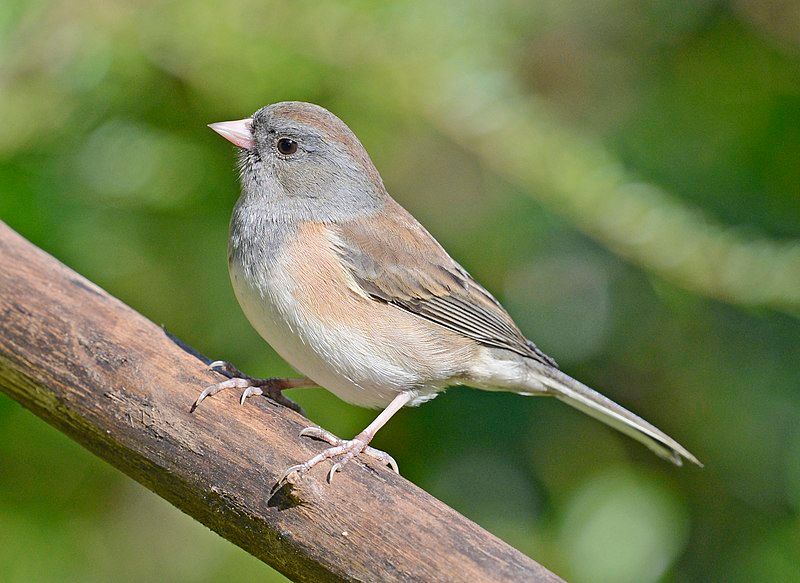
The dark-eyed Junco is a type of bird called a junco. Juncos are small, grayish sparrows that live in the New World. The dark-eyed Junco is found in many parts of temperate North America; during the summer, it even goes as far as the Arctic.
The dark-eyed Junco is a species that has a lot of variation. This means that different individuals of this bird can look quite different from one another. It is similar to another species of sparrow called the fox sparrow in terms of its variability.
Despite being studied by scientists, the systematics of the dark-eyed Junco are still not fully understood. Systematics refers to exploring the relationships between different species and their classification.
So, even though researchers have been trying to figure out how the dark-eyed Junco fits into the larger picture of bird species, there are still some unanswered questions.
| Kingdom | Animalia |
| Phylum | Chordata |
| Clade | Dinosauria |
| Class | Aves |
| Order | Passeriformes |
| Family | Passerellidae |
| Genus | Junco |
| Species | J. hyemalis |
5. California Towhee
The California towhee is a type of bird that belongs to the Passerellidae family.
It is found in specific areas, including the coastal regions of western Oregon and California in the United States and Baja California and Baja California Sur in Mexico. The taxonomy of the California towhee has been debated among experts.
Taxonomy refers to classifying organisms into different categories based on their similarities and evolutionary relationships.
In the case of the California towhee, experts have had discussions and disagreements about how to classify and categorize this particular bird species. One reason for the debate could be the similarities and differences the California towhee shares with other bird species.
Taxonomists compare various characteristics, such as physical features, behavior, and genetic information, to determine the relationships between different bird species.
However, in the case of the California towhee, some of these characteristics may not provide a clear distinction from other closely related species. Another reason for the ongoing debate could be the lack of comprehensive and conclusive research on the California towhee.
The scientific community constantly discovers new information about different species, which may lead to revisions in taxonomy. Lack of sufficient research or conflicting findings can contribute to the classification’s uncertainty.
| Kingdom | Animalia |
| Phylum | Chordata |
| Clade | Dinosauria |
| Class | Aves |
| Order | Passeriformes |
| Family | Passerellidae |
| Genus | Melozone |
| Species | M. crissalis |
6. Finches
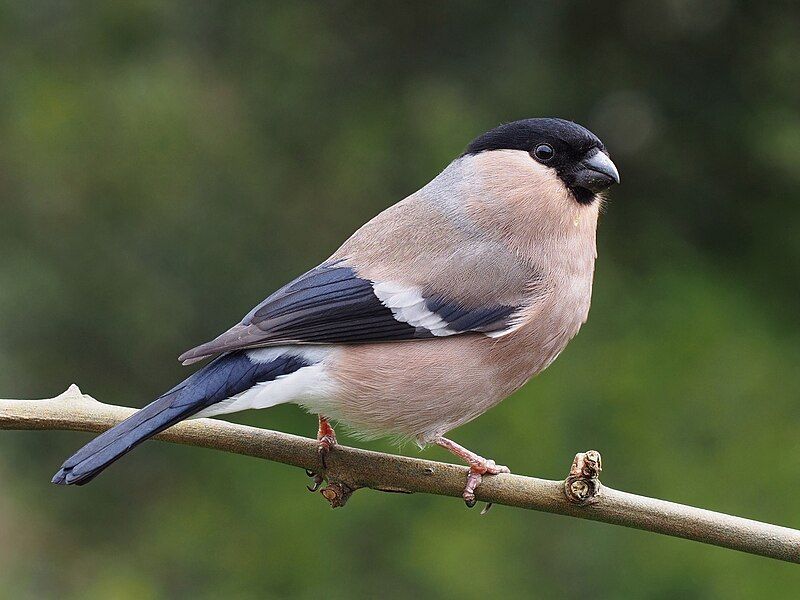
True finches are small- to medium-sized birds that belong to the family Fringillidae. They have a distinctive feature of having stout conical bills, which means their beaks are short and thick with a pointed shape.
These beak types are well-suited for their primary diet: seeds and nuts. In addition to their specialized bills, finches display vibrant and colorful feathers. These colorful plumages add to their beauty, making them visually appealing.
The specific colors and patterns on their feathers vary among different species of finches. Finches can be found in a wide variety of habitats. They are adaptable birds and can make their homes in forests, grasslands, mountains, and urban areas.
They are typically resident birds, meaning they stay in one place throughout the year and do not migrate to other regions. This makes their chosen habitat their permanent home.
By not migrating, finches can establish territories and maintain a stable population in their chosen habitat. They are able to find enough food and resources in their resident areas to survive and reproduce.
This is an advantage for them, as they do not have to undertake long and potentially dangerous journeys in search of food and suitable nesting.
| Kingdom | Animalia |
| Phylum | Chordata |
| Clade | Dinosauria |
| Class | Aves |
| Order | Passeriformes |
| Family | Fringillidae |
7. White-Crowned Sparrow
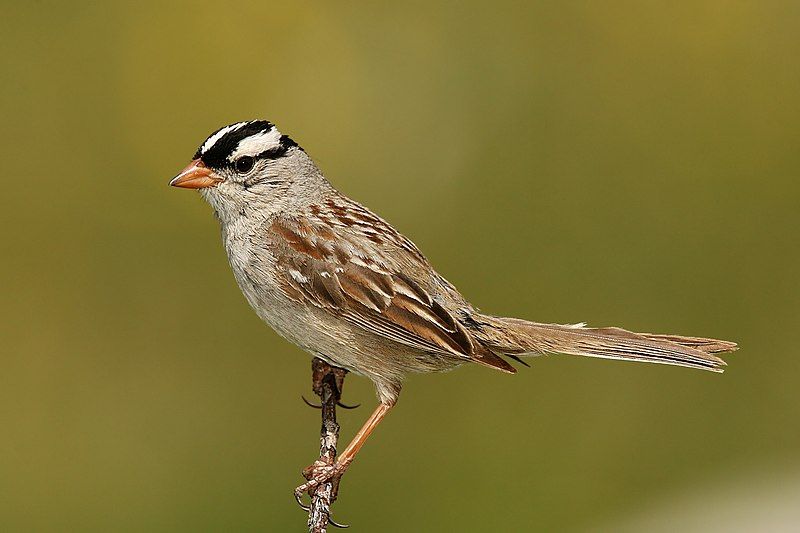
The white-crowned sparrow is a type of bird found in North America. It belongs to the passerine bird family, which means it is a perching bird.
This species is not too big or too small but falls into the category of medium-sized birds. One distinctive feature of the white-crowned sparrow is its grey face. The color of its face is different from the rest of its body, making it easy to identify.
The grey color gives the bird a unique and interesting appearance. Another characteristic of this species is the black and white streaking on its upper head. The streaks create a pattern that adds to the bird’s overall appearance.
These streaks are alternating black and white lines, giving the bird a striking and beautiful look. The black and white streaking on the white-crowned sparrow’s upper head is a notable feature because it contrasts with the rest of its body.
This contrast makes the bird stand out and catch the eye of observers. Seeing how nature has designed this bird with such distinct markings is interesting. The white-crowned sparrow’s grey face and black and white streaking on the upper head are unique to this species.
These characteristics help distinguish it from other.
| Kingdom | Animalia |
| Phylum | Chordata |
| Clade | Dinosauria |
| Class | Aves |
| Order | Passeriformes |
| Family | Passerellidae |
| Genus | Zonotrichia |
| Species | Z. leucophrys |
8. Mourning Dove
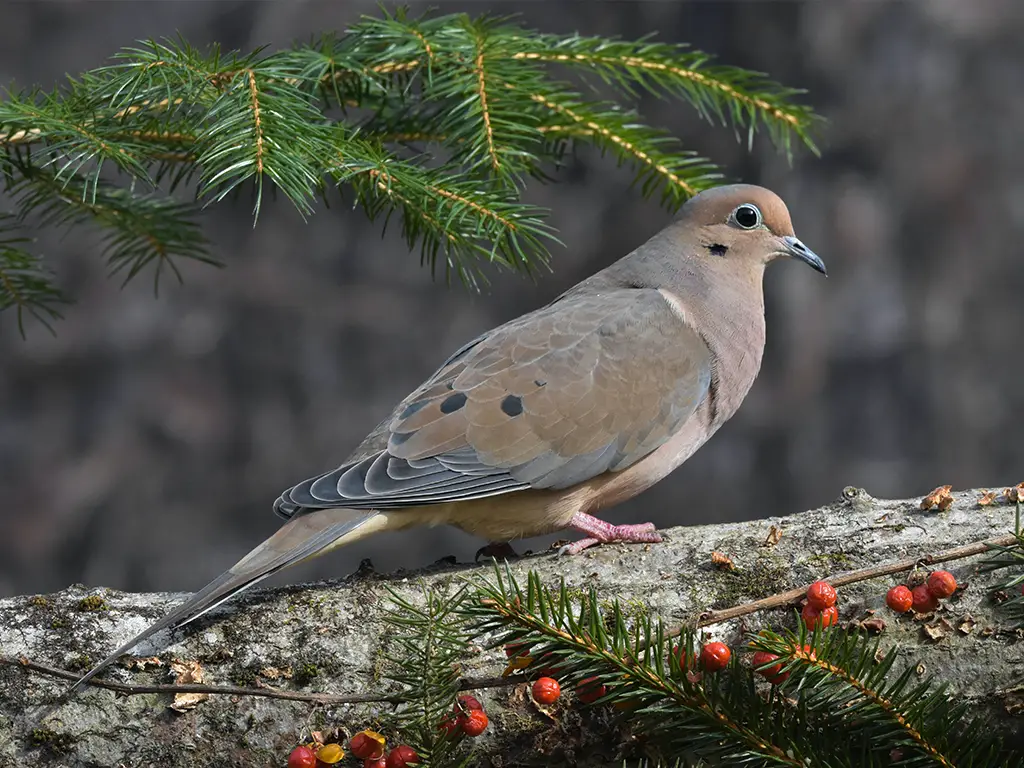
The mourning dove is a type of bird that belongs to the dove family called Columbidae. This bird is also known by different names, such as the American mourning dove, the rain dove, colloquially, and the turtle dove.
In the past, it was referred to as the Carolina pigeon and Carolina turtledove. The mourning dove is a common species found in North and Central America. It is recognized for its soft, mournful cooing sound, which gives it its name.
This bird is known for its slender body and long, pointed tail. It has a grayish-brown color with lighter shades on its underparts. One interesting fact about mourning doves is their ability to adapt to various habitats.
They can be found in different environments like forests, fields, urban areas, and deserts. They are known to thrive in both rural and suburban settings. Mourning doves primarily feed on seeds, grains, and fruits.
They have a unique diet as they can swallow seeds whole and store them in their crop, a specialized part of their digestive system. This allows them to eat in one location and then retreat to a safer place to digest their food. These birds are monogamous, meaning they mate.
| Kingdom | Animalia |
| Phylum | Chordata |
| Clade | Dinosauria |
| Class | Aves |
| Order | Columbiformes |
| Family | Columbidae |
| Genus | Zenaida |
| Species | Z. macroura |
9. Lesser Goldfinch
The lesser goldfinch is a tiny bird that can be found in the Americas. It belongs to a group called the New World goldfinch clade, along with two other species called the American goldfinch and Lawrence’s goldfinch.
All three species are part of the Spinus genus. One interesting characteristic of the lesser goldfinch is that the males have a black forehead. This feature is unique to male lesser goldfinches and is not present in females.
So, if you see a goldfinch with a black forehead, you can be sure it is a male lesser goldfinch. The black forehead is an important identification feature for distinguishing between male and female lesser goldfinches.
It helps birdwatchers and researchers determine the gender of these birds.
When observing a group of lesser goldfinches, they can easily spot the males with their distinctive black foreheads. It is worth noting that this black forehead trait is not exclusive to the lesser goldfinch.
Both the American goldfinch and Lawrence’s goldfinch also possess this characteristic.
This similarity in appearance suggests a close evolutionary relationship between these three species. By studying these New World goldfinches, scientists can gain insights into their evolutionary history and understand how different.
| Kingdom | Animalia |
| Phylum | Chordata |
| Clade | Dinosauria |
| Class | Aves |
| Order | Passeriformes |
| Family | Fringillidae |
| Genus | Spinus |
| Species | S. psaltria |
10. Song Sparrow
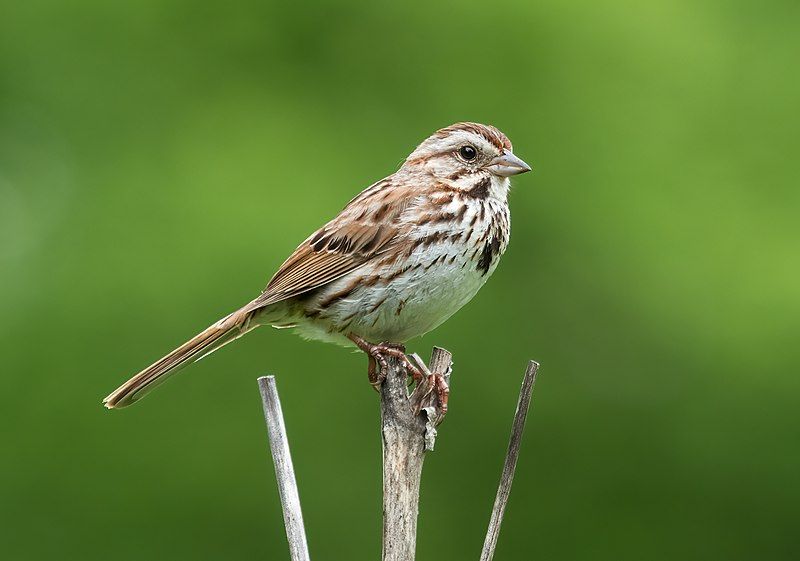
The song sparrow is a type of sparrow found in North America. It is considered to be medium-sized in comparison to other sparrows. Out of all the sparrows native to North America, the song sparrow is known to be one of the most abundant species.
This means that there are a large number of song sparrows in the wild. Not only is the song sparrow abundant, but it is also quite variable. This means that there can be different variations or types of song sparrows. They may have slight differences in appearance or behavior.
In addition to being abundant and variable, the song sparrow is also adaptable. This means that it can adjust well to different environments and conditions. It can thrive in various habitats, such as grasslands, marshes, and urban areas.
The adaptability of the song sparrow allows it to have a wide range of distribution. It can be found in many parts of North America, from Canada to Mexico. The song sparrow is a fascinating, medium-sized, abundant, variable, and adaptable bird.
Its ability to adapt to different environments has contributed to its success as a species in North America.
| Kingdom | Animalia |
| Phylum | Chordata |
| Clade | Dinosauria |
| Class | Aves |
| Order | Passeriformes |
| Family | Passerellidae |
| Genus | Melospiza |
| Species | M. melodia |
11. Old World Sparrows
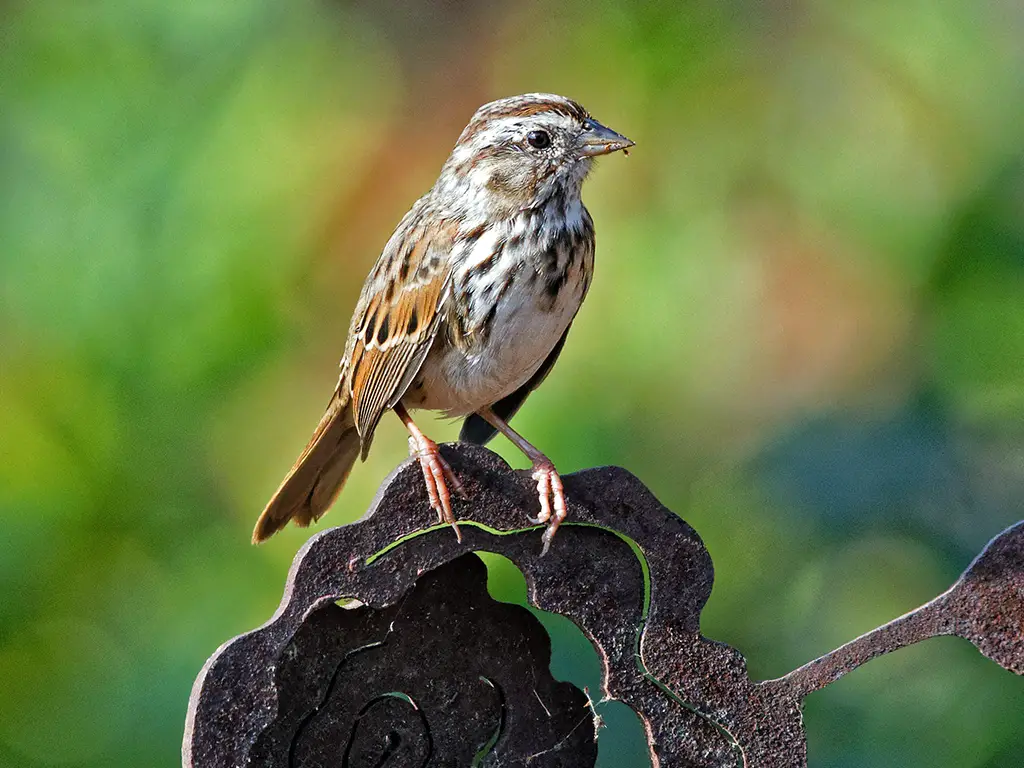
Old World sparrows belong to the family Passeridae, a group of small passerine birds. These birds are commonly referred to as true sparrows.
However, it is important to note that “true sparrows” are also used specifically for a particular genus within the Passeridae family called Passer. Passeridae is a family of birds that includes various species of sparrows.
These birds are found primarily in the Old World, which refers to the continents of Europe, Asia, and Africa.
They are well-known for their small size and characteristic features such as short, stout bills and rounded wings. The term “Old World sparrows” distinguishes these birds from their New World counterparts, including the Americas.
While there are some similarities between the two groups, Old World sparrows have distinct characteristics that set them apart. Old World sparrows are known for their adaptability and ability to thrive in various environments.
They can be found in a wide range of habitats, including grasslands, forests, urban areas, and agricultural landscapes.
These birds have successfully adapted to human-altered environments, often nesting in buildings and feeding on human-provided food sources. The genus Passer is a specific.
| Kingdom | Animalia |
| Phylum | Chordata |
| Clade | Dinosauria |
| Class | Aves |
| Order | Passeriformes |
| Family | Passeridae |
12. Golden-Crowned Sparrow
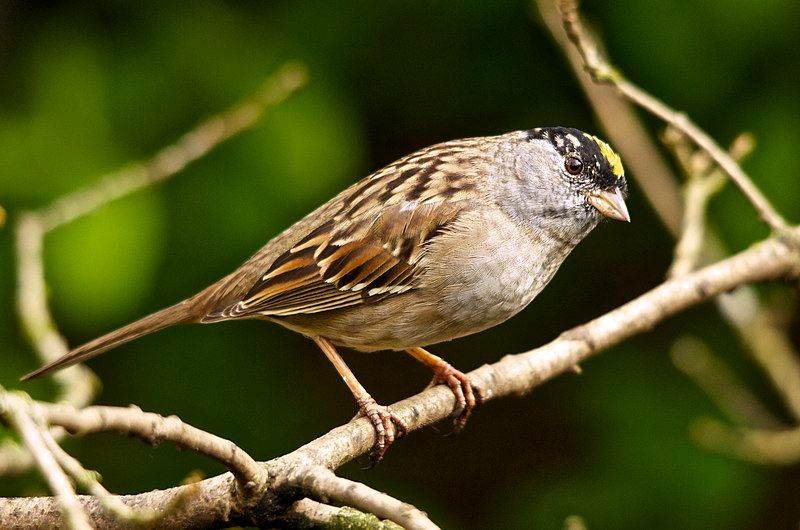
The golden-crowned sparrow is a type of bird known as a sparrow. It is found in the western part of North America. This species of bird is larger in size compared to other sparrows. The golden-crowned sparrow is native to the New World, which includes North and South America.
It is specifically found in the western region of North America. This region includes California, Oregon, Washington, and parts of Alaska. This bird is known for its distinct features, including a golden crown.
Hence, it is called the golden-crowned sparrow. The crown is bright yellow, making it easily identifiable.
This feature adds to the beauty of the bird and helps distinguish it from other species of sparrows. In terms of physical appearance, the golden-crowned sparrow has a plump body with a rounded shape. It has a short, thick bill, which it uses to forage for food.
The plumage of this bird is mostly gray and brown, with darker streaks on its back. The wings and tail have a touch of reddish-brown color, subtly contrasting the overall appearance. This species of sparrow is known to inhabit.
| Kingdom | Animalia |
| Phylum | Chordata |
| Clade | Dinosauria |
| Class | Aves |
| Order | Passeriformes |
| Family | Passerellidae |
| Genus | Zonotrichia |
| Species | Z. atricapilla |
13. Yellow-Rumped Warbler
The yellow-rumped warbler is a type of bird found in North America. It is quite common and can be seen in many different places across the continent. This bird species is known for its distinct yellow feathers on its rump or lower back.
This is where it gets its name from. These yellow feathers make it easy to identify the yellow-rumped warbler in the wild. The yellow-rumped warbler is a small bird, measuring around 5 to 6 inches in length. It has a slim body with a pointed beak and long wings.
Its wingspan can reach up to 9 to 10 inches, allowing it to fly swiftly and gracefully. One interesting fact about this bird is that it is known for its ability to migrate long distances. Yellow-rumpedrth America.
During the breeding season, however, they migrate south to warmer regions, such as Mexico and Central America. When winter arrives, this bird species can be found in various habitats. It is often seen in forests, woodlands, and even urban areas.
It has adapted well to different environments and can thrive in both deciduous and coniferous forests. The yellow-rumped warbler has a diverse.
| Kingdom | Animalia |
| Phylum | Chordata |
| Clade | Dinosauria |
| Class | Aves |
| Order | Passeriformes |
| Family | Parulidae |
| Genus | Setophaga |
| Species | S. coronata |
14. Crow Family

The Corvidae family is a group of birds that can be found all around the world. It includes various species such as crows, ravens, rooks, magpies, jackdaws, jays, treepies, choughs, and nutcrackers. These birds are known as the crow family or corvids in everyday English.
Currently,35 different species are considered part of the Corvidae family. Each species has its own unique characteristics and traits. Some of them have black feathers, while others may have a mix of black and white or even colorful plumage.
These corvids are part of the oscine passerine birds, which means they are known for their complex vocalizations. They have various calls and songs, communication, and social interactions.
This ability to communicate through sound is one of the distinguishing features of the Corvidae family. Corvids are also known for their intelligence and problem-solving skills. They are considered to be one of the most intelligent groups of birds.
They have been observed using tools, solving puzzles, and even demonstrating a level of self-awareness. This intelligence allows them to adapt to various environments and find innovative ways.
| Kingdom | Animalia |
| Phylum | Chordata |
| Clade | Dinosauria |
| Class | Aves |
| Order | Passeriformes |
| Family | Corvidae |
15. Northern Flicker
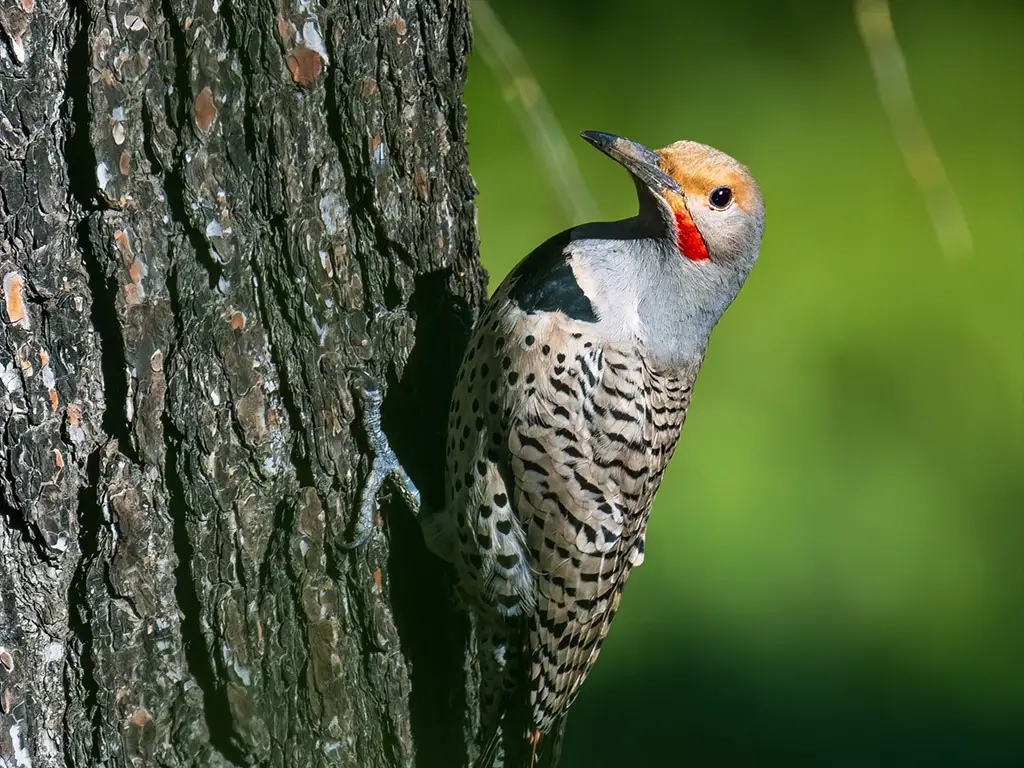
The northern flicker is a type of bird that belongs to the woodpecker family. It is not a very large bird, but it is not too small. The northern flicker can be found in many parts of North America.
It is also native to some areas in Central America, such as Cuba and the Cayman Islands. One interesting thing about the northern flicker is that it is one of the few woodpecker species that migrate.
Migration means that these birds travel from one place to another during different seasons. They do this to find food and suitable habitats.
The northern flicker migrates to different regions depending on the time of year. During the breeding season, which is usually in the spring or summer, the northern flicker can be found in many parts of North America.
They build their nests in trees and use their strong beaks to create holes in the wood. These holes are called cavities and serve as their homes. Northern flickers are known for their distinctive markings.
They have a brown body with black spots, and their wings have a white patch easily visible when flying. Another unique feature is the red or yellow coloration on the underside of their wings and tail.
| Kingdom | Animalia |
| Phylum | Chordata |
| Clade | Dinosauria |
| Class | Aves |
| Order | Piciformes |
| Family | Picidae |
| Genus | Colaptes |
| Species | C. auratus |
16. American Robin
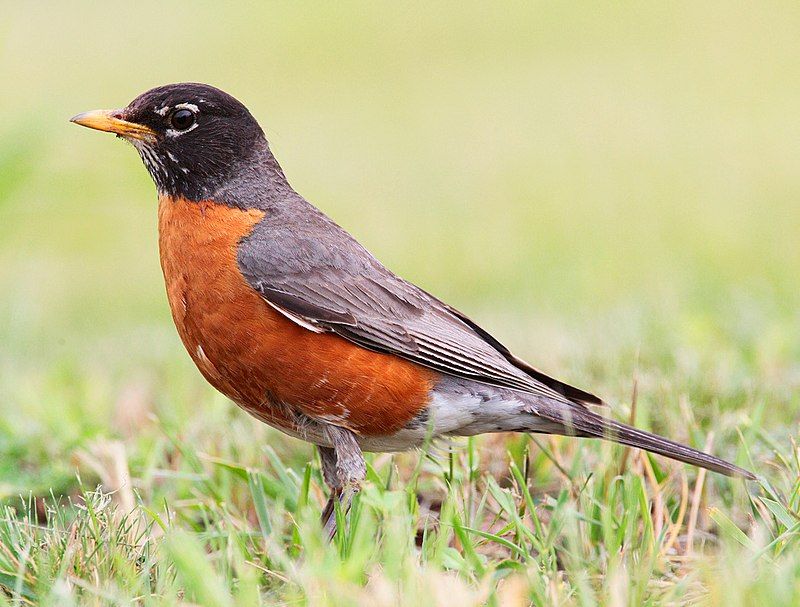
The American robin is a type of bird that migrates. It belongs to the true thrush genus and the Turdidae family, which is an enormous thrush family and gets its name from the European robin because of its reddish-orange breast.
However, it is important to note that the American and European robin are not closely related. The European robin is a different species and belongs to the Old World flycatcher family.
Despite their similar names and physical characteristics, these two birds are not closely related in terms of their genetic makeup.
They may share some similarities in appearance, such as the reddish-orange breast, but their evolutionary paths have taken them in different directions. The American robin is primarily found in North America, while the European robin is native to Europe and parts of Asia.
Both species have adapted to their respective environments and habitats over time.
The American robin is known for its ability to migrate long distances, often traveling south during the and returning north for the breeding season. In terms of physical characteristics, the American robin is larger than the European robin.
It has a grayish-brown back and a distinct reddish-orange breast, which is a defining feature of the species.
| Kingdom | Animalia |
| Phylum | Chordata |
| Clade | Dinosauria |
| Class | Aves |
| Order | Passeriformes |
| Family | Turdidae |
| Genus | Turdus |
| Species | T. migratorius |
17. Black Phoebe
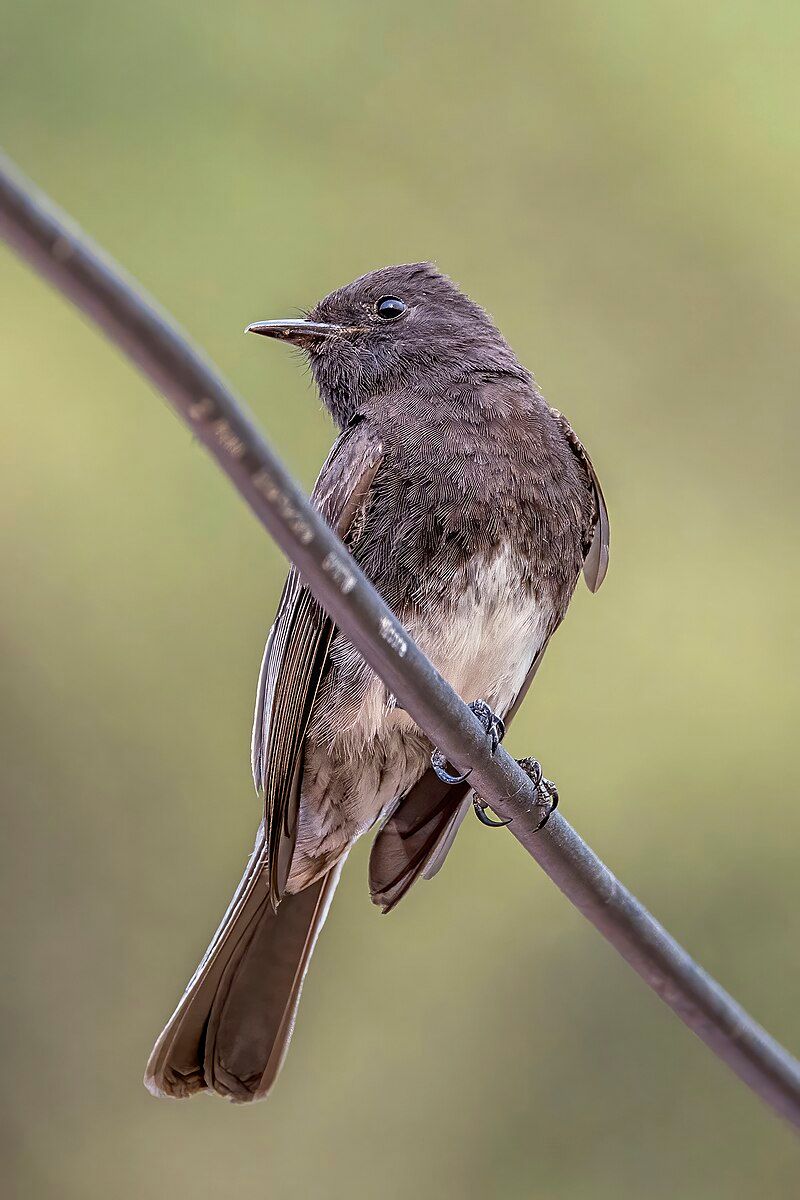
The black phoebe is a type of bird that belongs to the passerine family. This family of birds is known for their perching ability and their melodious songs.
The black phoebe specifically falls into the category of tyrant flycatchers, known for their hunting behavior of catching insects on the fly. This bird is found in various regions, starting from southwest Oregon and California, and extending all the way down to Central and South America.
It is a widespread species that is present throughout most of its range all year round. This means you can consistently find black phoebes in these areas regardless of the season. Unlike some other birds in its genus, the black phoebe does not migrate long distances.
Migration is the seasonal movement of birds from one region to another in search of food, breeding grounds, or better weather conditions. However, in the case of the black phoebe, only its northern populations engage in partial migration.
This means that while some black phoebes in the north might migrate, others choose to remain in their current location. Overall, the black phoebe is a fascinating bird that can be found across a large geographical area.
| Kingdom | Animalia |
| Phylum | Chordata |
| Clade | Dinosauria |
| Class | Aves |
| Order | Passeriformes |
| Family | Tyrannidae |
| Genus | Sayornis |
| Species | S. nigricans |
18. Common Starling
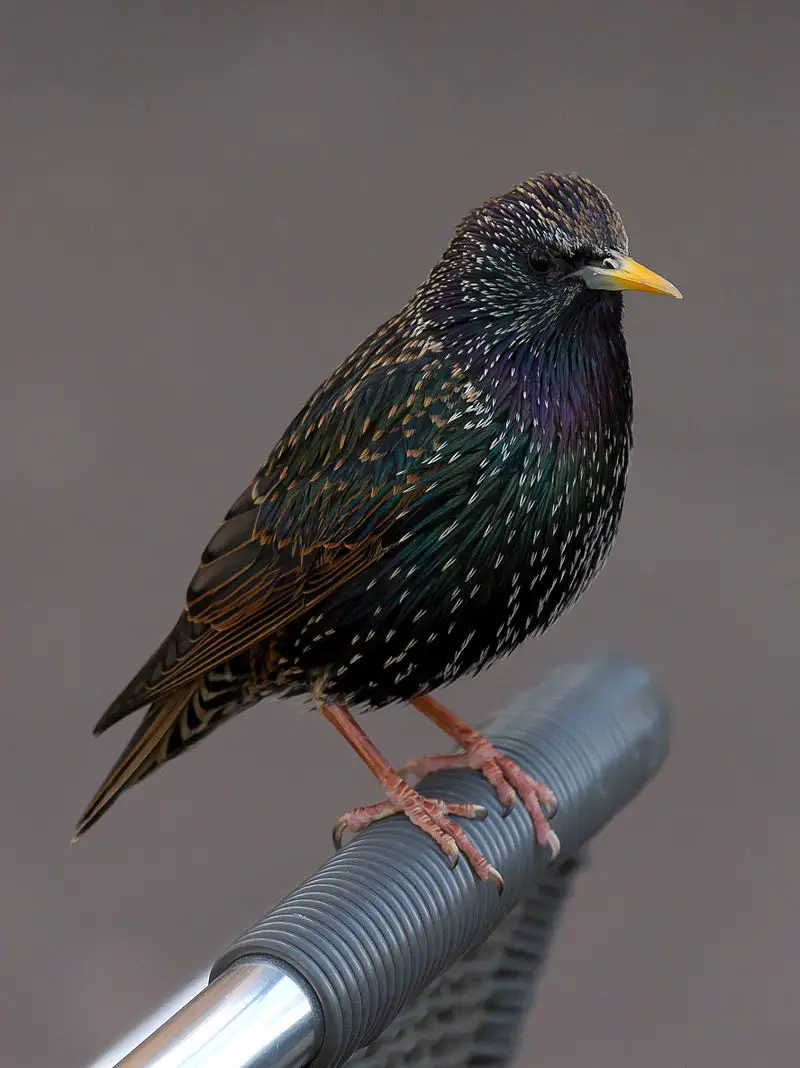
The common starling is a type of bird that can be found in various regions. Depending on the location, it is referred to by different names. It is known as the European starling in North America, while it is called the starling in Great Britain and Ireland.
This bird belongs to the starling family, scientifically known as Sturnidae. WiTheommon starling is classified as a passerine bird. With their medium-sized build, Passerine birds are characterized by having feet adapted for perching, making up the largest order of birds.
The starling family, to which the common starling belongs, is known for its diverse species around the world. The common starling is known for its unique features and behaviors. It has a sleek and shiny black plumage with speckled spots, which gives it a distinct appearance.
The bird’s feathers can also appear iridescent in certain lighting conditions, showcasing shades of green and purple. One of the remarkable aspects of the common starling is its ability to mimic sounds and voices.
It has a wide range of vocalizations and can imitate various sounds it hears in its environment, including other bird calls, human speech, and even mechanical noises.
| Kingdom | Animalia |
| Phylum | Chordata |
| Clade | Dinosauria |
| Class | Aves |
| Order | Passeriformes |
| Family | Sturnidae |
| Genus | Sturnus |
| Species | S. vulgaris |
19. Ruby-Crowned Kinglet
The ruby-crowned kinglet is a small bird that can be found all over North America. It belongs to the kinglet family, which includes other small bird species. This bird has olive-green feathers that cover its body.
Additionally, it has two white bars on its wings and a white ring around its eye. If we look closely, we can notice some differences between males and females of the species. The male ruby-crowned kinglet has a special feature on its head – a red patch on its crown.
However, this patch is not always visible as it is often hidden. On the other hand, female ruby-crowned kinglets do not have this red crown patch. Despite their small size, these birds are known for their energetic and active behavior.
They are constantly flying and hopping from branch to branch in search of food. Ruby-crowned kinglets primarily feed on insects, spiders, and small invertebrates found in trees and shrubs. One interesting fact about these birds is that they are known to be quite vocal.
They produce a variety of sounds to communicate with each other. Their songs consist of high-pitched and rapid notes, which can be quite melodic and pleasant to hear. During the breeding season, male ruby-crowned.
| Kingdom | Animalia |
| Phylum | Chordata |
| Clade | Dinosauria |
| Class | Aves |
| Order | Passeriformes |
| Family | Regulidae |
| Genus | Corthylio |
| Species | C. calendula |
20. American Bushtit
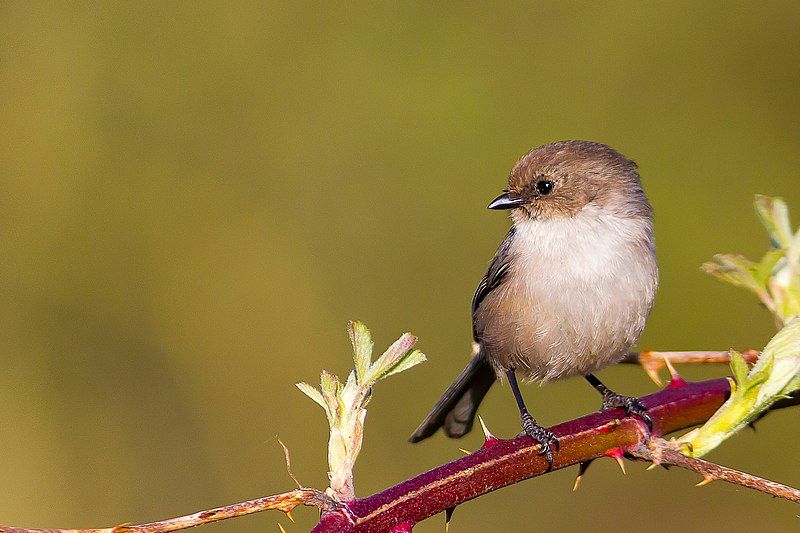
The American bushtit, also known as the bushtit, is a small songbird. It belongs to the genus Psaltriparus. In fact, it is one of the smallest passerines, or perching birds, in North America.
However, it is not only its size that makes it unique. Out of all the species in the family Aegithalidae, the American bushtit is the only one found in the United States. The remaining seven species can be found in Eurasia.
This makes the American bushtit quite special and distinct in its habitat. Being a social bird, the American bushtit often forms flocks consisting of several individuals. It enjoys the company of its fellow bushtits.
This social behavior sets it apart from some other bird species. Despite its small size, the American bushtit has a beautiful song. It uses its melodious voice to communicate with other members of its flock.
This song is an important part of social interactions and helps maintain harmony within the group. In terms of appearance, the American bushtit has a unique look. It has a plump body with a long tail. Its plumage is generally gray-brown.
| Kingdom | Animalia |
| Phylum | Chordata |
| Clade | Dinosauria |
| Class | Aves |
| Order | Passeriformes |
| Family | Aegithalidae |
| Genus | Psaltriparus |
| Species | P. minimus |
21. American Crow
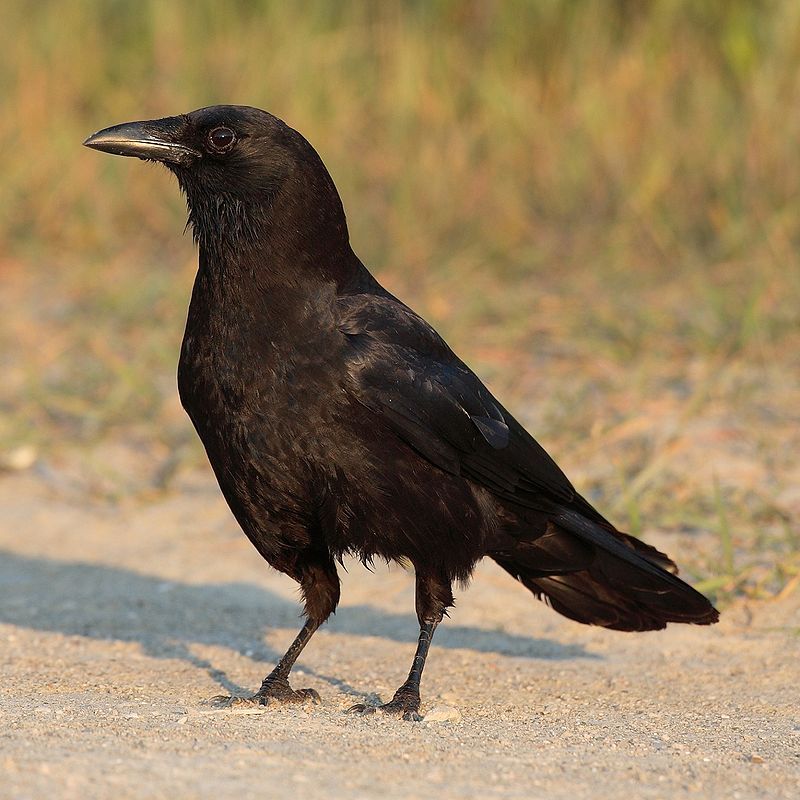
The American crow is a type of bird that belongs to the Corvidae family. This family includes other birds like ravens and jays. The American crow is quite big and is known as a passerine bird, meaning it has feet perching on branches.
You can find American crows in many parts of North America. They are very common bibirdsso so you might have seen them in your neighborhood. They have adapted well to different environments and can be found in urban areas, forests, and even open fields.
Interestingly, American crows are similar to two other types of crows found in different parts of the world. These are the carrion and hooded crow found in Europe and Asia.
Despite being from different continents, these three crows occupy the same ecological niche. An ecological niche refers to the role a species plays in its environment. In this case, the American crow, carrion crow, and hooded crow all have similar behaviors and habits.
They are opportunistic feeders, meaning they eat a wide range of things like insects, fruits, small animals, and even garbage. They also play important roles in controlling populations of certain pests and scaveng.
| Kingdom | Animalia |
| Phylum | Chordata |
| Clade | Dinosauria |
| Class | Aves |
| Order | Passeriformes |
| Family | Corvidae |
| Genus | Corvus |
| Species | C. brachyrhynchos |
22. New World Warblers
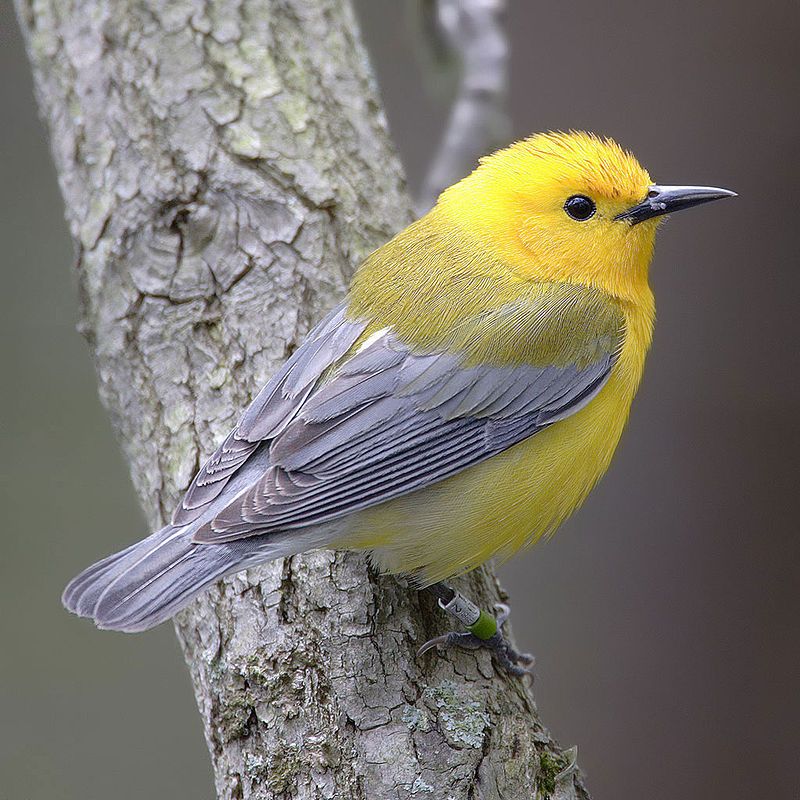
The New World warbler, also known as the excellent warbler, is a small bird in the Americas. These birds are often vibrant and eye-catching, with colorful plumage that stands out in their surroundings.
They belong to the faParulidae family, a group of passerine birds with specialized feet for perching. Unlike some other bird species, New World warblers are only found in the Americas. They are not seen in other parts of the world, such as Europe or Asia.
This geographical restriction sets them apart from Old World warblers, which are found in Europe, Asia, and Africa.
Similarly, they are not closely related to Australian warblers, which are native to Australia and nearby regions. The New World warblers have their own distinct characteristics and evolutionary history.
Although they may share some similarities in behavior or appearance with other warbler species, they have evolved separately and have distinct genetic lineages.
Their unique adaptation to the New World environment has shaped their physical traits and behaviors. One of the notable features of New World warblers is their colorful plumage. Many species exhibit vibrant hollow, blue, green, and red hues, making them a delight to observe.
| Kingdom | Animalia |
| Phylum | Chordata |
| Clade | Dinosauria |
| Class | Aves |
| Order | Passeriformes |
| Family | Parulidae |
23. Turkey Vulture
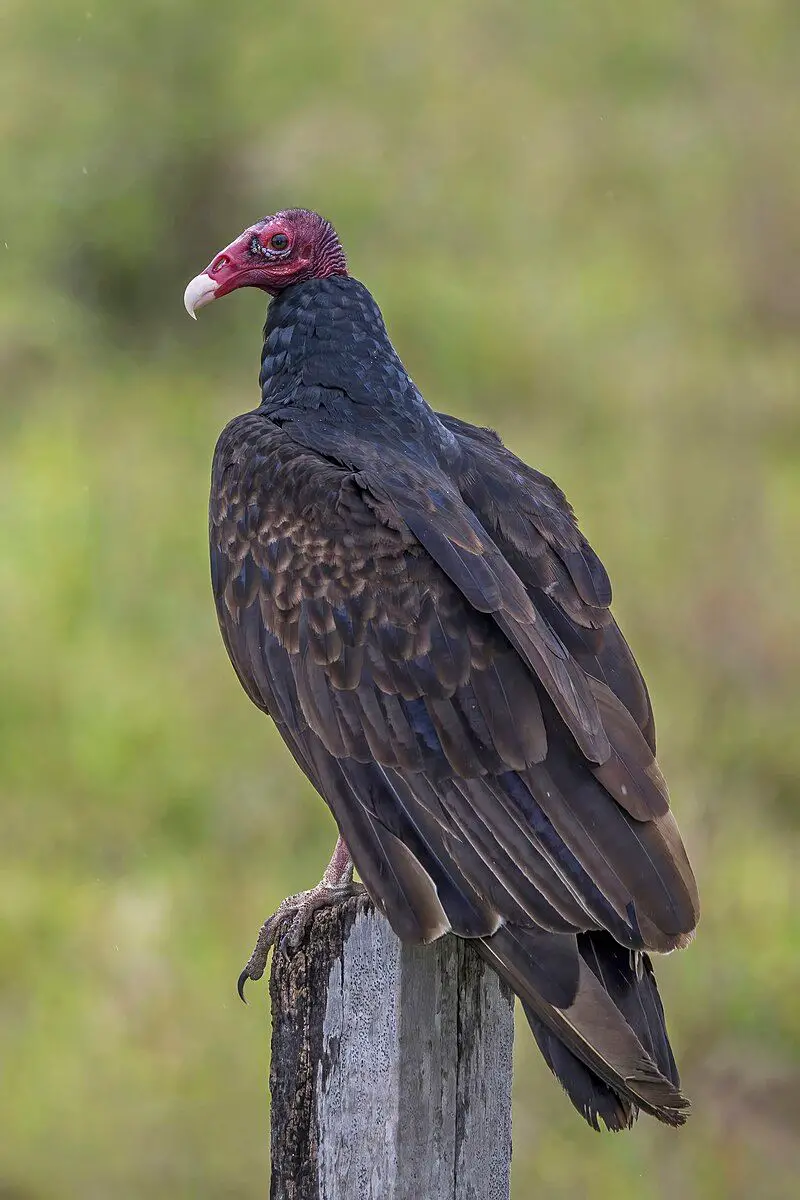
The turkey vulture is a type of vulture that can be found in many different parts of the Americas. It is actually the most widespread of all the New World vultures. There are three species of vultures in a group called the genus Cathartes.
The turkey vulture is one of these species. It belongs to the Cathartidae family, a bird group that includes vultures. The turkey vulture can be found in a vast range of locations.
It can be seen from southern Canada, all the way down to the very tip of South America. This means that it can be found in many different countries and environments throughout the Americas. This bird has a very large range because it is well adapted to various habitats.
It is able to thrive in a wide range of conditions and climates. The turkey vulture is known for its characteristic appearance. It has a bald head, which is red in color. Its body is mostly black or dark brown, and it has long wings and a long tail.
This vulture is a scavenger, which means that it feeds on dead animals. It has a highly developed sense of smell, which allows it to locate carrion from high.
| Kingdom | Animalia |
| Phylum | Chordata |
| Clade | Dinosauria |
| Class | Aves |
| Order | Accipitriformes |
| Family | Cathartidae |
| Genus | Cathartes |
| Species | C. aura |
24. Double-Crested Cormorant
The double-crested cormorant is a type of bird that belongs to the cormorant family. It can be commonly seen near bodies of water such as rivers and lakes. You can also find this bird in coastal areas.
It is not limited to just one region, as it is widely distributed across North America. These birds can be found in various locations throughout North America. From the Aleutian Islands in Alaska, all the way down to Florida and Mexico, they can be seen in different habitats.
This means that they have adapted to survive in a wide range of environments. Being part of the cormorant family, the double-crested cormorant shares certain characteristics with other birds in the same family.
They have long necks and bodies, which are ideal for swimming and diving in water. Their webbed feet help them paddle through the water easily. Due to their ability to swim and dive, the double-crested cormorant can catch fish as their primary source of food.
They are excellent underwater hunters, using their sharp beaks to snatch fish from the water. These birds have a unique feature – they have bright blue eyes with two tufts of feathers above them.
| Kingdom | Animalia |
| Phylum | Chordata |
| Clade | Dinosauria |
| Class | Aves |
| Order | Suliformes |
| Family | Phalacrocoracidae |
| Genus | Nannopterum |
| Species | N. auritum |
25. Great Egret
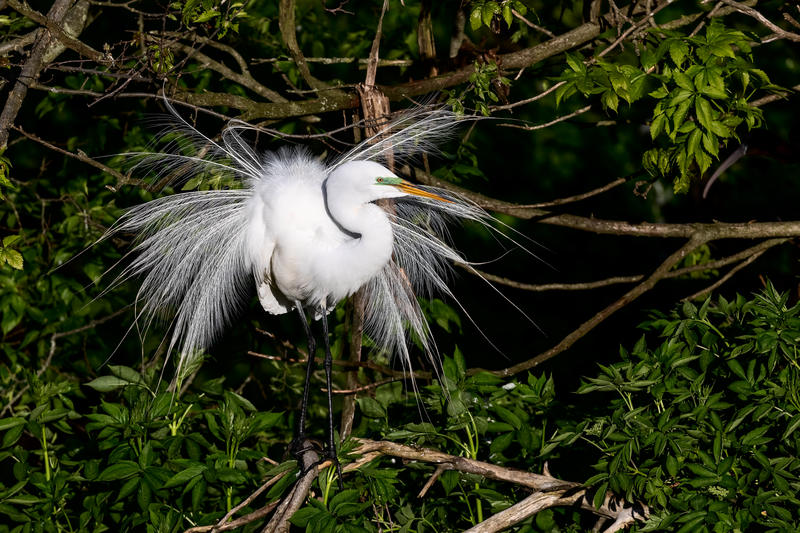
The great egret is a type of bird that is also commonly referred to as the common egret, large egret, great white egret, or great white heron. It is known for its large size and can be found in many different parts of the world.
The great egret has four subspecies, each of which is found in different regions. One subspecies of the great egret is found in Asia. These birds can be seen in various countries across the continent.
They are known for their elegant appearance and are often found near bodies of water, such as rivers, lakes, and ponds. Another subspecies of the great egret is found in Africa.
These birds can be spotted in different habitats throughout the continent, including wetlands, marshes, and coastal areas. They are skilled hunters and feed on fish, frogs, and other small aquatic creatures. The third subspecies of the great egret is found in the Americas.
This includes both North and South America. These birds can be found in a range of environments, such as swamps, estuaries, and even urban areas.
They are known for their graceful flight and striking white plumage. The final subspecies of the great egret is found in southern Europe.
| Kingdom | Animalia |
| Phylum | Chordata |
| Clade | Dinosauria |
| Class | Aves |
| Order | Pelecaniformes |
| Family | Ardeidae |
| Genus | Ardea |
| Species | A. alba |
26. American Coot
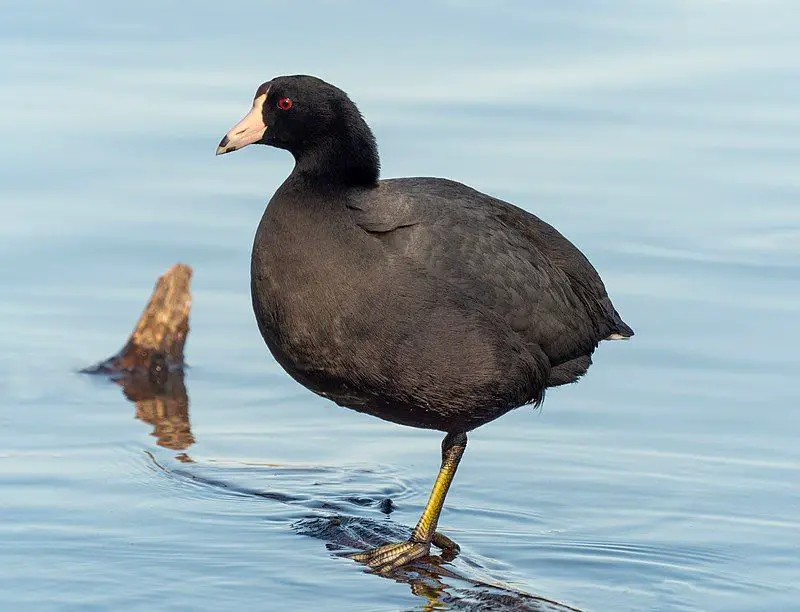
The American coot is a bird that is often confused with ducks. However, it actually belongs to a different family called Rallidae. This means that deots and ducks are not closely related. Despite some similarities, they are sometimes called mud hens or rouleau.
These names highlight their preference for watery habitats, such as marshes, ponds, and lakeshores. They are well-adapted to living in these environments. Unlike ducks, coots have a distinct body shape. They have a plump body, short tail, and a chicken-like beak.
This unique appearance helps to differentiate them from ducks. In terms of their behavior, coots are known for their strong swimming abilities. They have lobed toes, which are not webbed like ducks, but instead have flaps of skin that aid in propulsion through the water.
This allows them to navigate through the water with ease. Another interesting fact about coots is that they are primarily herbivorous. They feed on aquatic plants, algae, and sometimes even insects.
Their diet is well-suited to their habitat, as they can often find an abundance of plant material in the shallow waters they inhabit. Coots are high.
| Kingdom | Animalia |
| Phylum | Chordata |
| Clade | Dinosauria |
| Class | Aves |
| Order | Gruiformes |
| Family | Rallidae |
| Genus | Fulica |
| Species | F. americana |
27. House sparrow
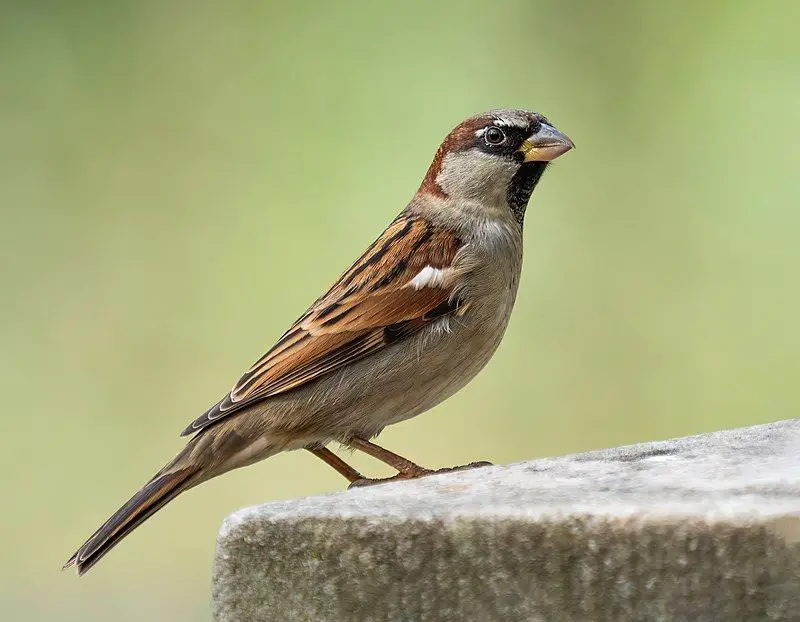
The house sparrow is a type of bird that belongs to the sparrow family called Passeridae. These birds can be found in many different parts of the world. They are quite small in size, typically measuring about 16 cm in length.
In terms of weight, they usually range between 24 to 39.5 grams. Regarding their appearance, female and young house sparrows are generally colored in pale shades of brown and grey.
This coloration helps them blend in with their surroundings and provides them with some camouflage. On the other hand, male house sparrows have more vibrant colors.
They display ack, white, and brown markings, making them easily distinguishable from the females and young birds.
The contrasting colors of the male house sparrows serve various purposes. Firstly, these colors help attract mates during the breeding season.
The brighter markings act as a visual signal to the females, indicating that the male is healthy and capable of providing for offspring.
These markings also play a role in defending territory and establishing dominance among other male sparrows. The house sparrow’s coloration is not only limited to their feathers. They also have distinct beak colors that differ between males and females.
| Kingdom | Animalia |
| Phylum | Chordata |
| Clade | Dinosauria |
| Class | Aves |
| Order | Passeriformes |
| Family | Passeridae |
| Genus | Passer |
| Species | P. domesticus |
28. Juncos
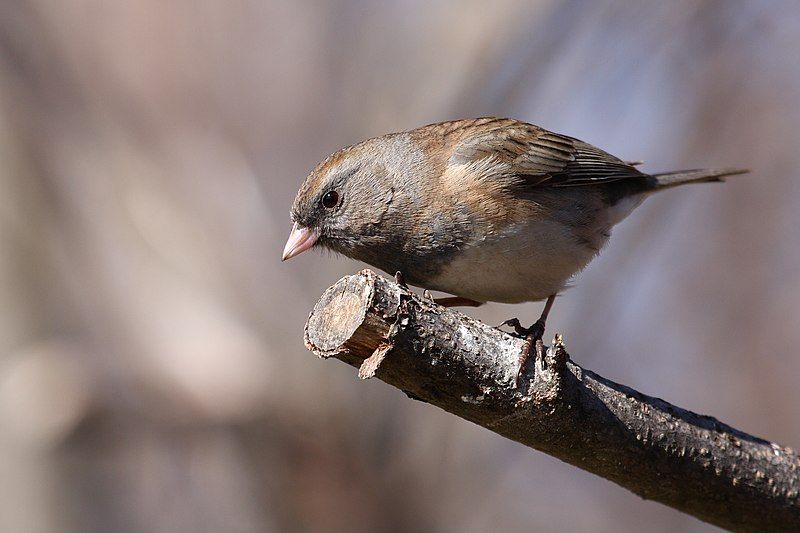
The paragraph introduces a bird called a junco, which belongs to the genus Junco. It is a small bird found in North America and belongs to the Passerellidae family, which includes sparrows.
Scientists have been studying the classification of juncos for many years, but it is still a confusing topic. The term “Junco systematics” refers to the classification and organization of different junco species.
Despite decades of research, there is still uncertainty about how many distinct species of juncos there are. Different authors have different opinions on the number of junco species.
Some authors accept that there are only three species, while others believe there could be as many as twelve.
This variation in viewpoints indicates the ongoing confusion and lack of consensus within the scientific community. The confusion surrounding junco systematics suggests that identifying and categorizing junco species is not straightforward.
It implies that there may be significant differences in characteristics or genetic variations among the juncos, leading to differing interpretations by researchers.
To resolve this confusion, researchers continue to conduct studies and analyze various aspects of juncos, such as their physical appearances, genetic traits, and behavioral patterns.
| Kingdom | Animalia |
| Phylum | Chordata |
| Clade | Dinosauria |
| Class | Aves |
| Order | Passeriformes |
| Family | Passerellidae |
| Genus | Junco |
29. Oak Titmouse
The oak titmouse is a type of bird that belongs to the tit family called Paridae. In 1996, the American Ornithologists’ Union separated the plain titmouse into two species: the oak titmouse and the juniper titmouse.
This decision was made because the oak titmouse and the juniper titmouse have noticeable differences in their song, preferred habitat, and genetic makeup. One of the reasons for classifying the oak titmouse as a distinct species is its song.
The oak titmouse has a unique song that is different from the juniper titmouse.
By studying these birds’ songs, ornithologists could identify apparent differences between the two species. Another factor that led to the separation of these birds is their preferred habitat. The name suggests that the oak titmouse is primarily found in oak woodlands.
On the other hand, the juniper titmouse prefers to live in areas with juniper trees.
This difference in habitat preference further supports the idea that they are separate species. Furthermore, genetic analysis played a crucial role in determining the distinction between these two birds.
Scientists studied the genetic makeup of both the oak titmouse and the juniper titmouse and found notable variations between them.
| Kingdom | Animalia |
| Phylum | Chordata |
| Clade | Dinosauria |
| Class | Aves |
| Order | Passeriformes |
| Family | Paridae |
| Genus | Baeolophus |
| Species | B. inornatus |
30. Grebes
Grebes are a type of bird that live in water and dive underwater. They belong to the order Podicipediformes. These birds are found in various freshwater habitats and can also be seen in marine environments during migration and winter.
Many different species of grebes exist, and they are spread out over a wide area. Some species are even capable of flight, while others are flightless.
It is interesting to note that flightless grebes are most commonly found in lakes that have a stable and consistent environment. Flightless grebes are unable to fly like other birds due to certain physical adaptations.
However, they have evolved to be excellent swimmers and divers. Their wings have become smaller and less efficient for flying, but they have strong legs and webbed feet that help them propel through the water.
Grebes are known for their ability to dive underwater in search of food. They have specialized adaptations for this, such as dense bones that make them less buoyant and allow them to dive deeper.
Their feathers are also waterproof, which helps keep them dry and warm while swimming. These birds have a varied diet, consisting mainly of small fish, insects, and aquatic vegetation. They use their sharp beaks to catch their prey while.
| Kingdom | Animalia |
| Phylum | Chordata |
| Clade | Mirandornithes |
| Class | Aves |
| Order | Podicipediformes |
| Family | Podicipedidae |
31. Chestnut-Backed Chickadee
The chestnut-backed chickadee is a small bird that belongs to the tit family, known as Paridae. It used to be called Parus rufescens. This bird is commonly found in the Pacific Northwest region of the United States and western parts of Canada.
It can be seen in areas ranging from southeastern Alaska to southwestern California. The chestnut-backed chickadee prefers to live in regions near the coast that have a humid and foggy climate. It tends to stay close to the shoreline.
These birds are known for their distinct appearance. They have a chestnut-colored back, which gives them their name. They also have a black cap on their head and a white face. The rest of their body is a grayish color.
The chestnut-backed chickadee is a passerine bird, meaning it sings and communicates through its melodious songs. It is known for its cheerful and lively calls, which can be heard throughout the day. These birds are highly active and agile.
They often hopped and flew from tree to tree, searching for food. They have a varied diet that includes insects, seeds, berries, and small fruits. The chestnut-backed chickadee is a social.
| Kingdom | Animalia |
| Phylum | Chordata |
| Clade | Dinosauria |
| Class | Aves |
| Order | Passeriformes |
| Family | Paridae |
| Genus | Poecile |
| Species | P. rufescens |
32. Allen’s Hummingbird
Allen’s hummingbird is a type of hummingbird that can be found in the western part of the United States.
It is one of seven different species of hummingbirds belonging to the genus Selasphorus. These hummingbirds are known for their small size and incredible flying abilities. They are often seen hovering in mid-air or darting quickly from one flower to another.
Despite their tiny size, they have incredibly fast wingbeats, which can reach up to 60 times per second. The breeding range of Allen’s hummingbird is mainly concentrated in the western United States.
They can be found in various habitats such as coastal areas, forests, and even urban gardens.
During the breeding season, the male hummingbirds display their vibrant plumage, which includes a brilliant orange-red throat patch known as a gorget. On the other hand, female Allen’s hummingbirds have more subdued colors, with a greenish back and a white breast.
They build small, cup-shaped nests made of plant fibers and spider silk.
These nests are usually constructed in shrubs or trees, providing a safe space for the female to lay her eggs and raise her young. Like other hummingbirds, Allen’s hummingbirds have a specialized diet consisting mainly of.
| Kingdom | Animalia |
| Phylum | Chordata |
| Clade | Strisores |
| Class | Aves |
| Order | Apodiformes |
| Family | Trochilidae |
| Genus | Selasphorus |
| Species | S. sasin |
33. Thrush
The thrushes are a type of bird that belongs to the passerine bird family called Turdidae. This family of birds is found all over the world. In the past, the Turdidae family was even bigger than it is now.
However, biologists decided to reclassify a group of birds called the Saxicolinae, which includes chats and European robins. They were moved to a different family called Old World flycatchers. This reclassification by biologists led to a change in the size of the thrush family.
The Saxicolinae, which were once considered a part of the thrush family, were now placed in a new family known as Old World flycatchers.
This decision was made based on certain characteristics and similarities that these birds share. Chats and European robins, which were previously considered part of the thrush family, are now classified as Old World flycatchers.
This means that they are no longer included in the Turdidae family. Instead, they have their own separate family designation. The term “Old World” refers to Europe, Asia, and Africa, which are the regions where these flycatchers are commonly found.
| Kingdom | Animalia |
| Phylum | Chordata |
| Clade | Dinosauria |
| Class | Aves |
| Order | Passeriformes |
| Family | Turdidae |
34. Cape May Warbler
The Cape May warbler is a type of bird known as a New World warbler. This species is found in North America. During the breeding season, the Cape May warbler can be found in northern America. It nests and raises its young in this region.
The Cape May warbler’s breeding range covers a large area, with the exception of the westernmost parts of southern Canada, the Great Lakes region, and New England. These areas are not suitable for the bird’s breeding activities.
Interestingly, the Cape May warbler is a migratory bird. This means that it travels long distances during certain times of the year. DuTheape May warbler can be found in the West Indies.
During the winter. The reason for its migration is likely due to food availability. The Cape May warbler relies on insects for sustenance; during the winter months, insects are scarce in its breeding range.
By traveling to the West Indies, where insects are more abundant, the bird ensures its survival during this time. The Cape May warbler’s migration is an impressive feat.
It undertakes a long journey from its breeding grounds in northern North America all the way to the West Indies.
| Kingdom | Animalia |
| Phylum | Chordata |
| Clade | Dinosauria |
| Class | Aves |
| Order | Passeriformes |
| Family | Parulidae |
| Genus | Setophaga |
| Species | S. tigrina |
35. Cooper’s Hawk
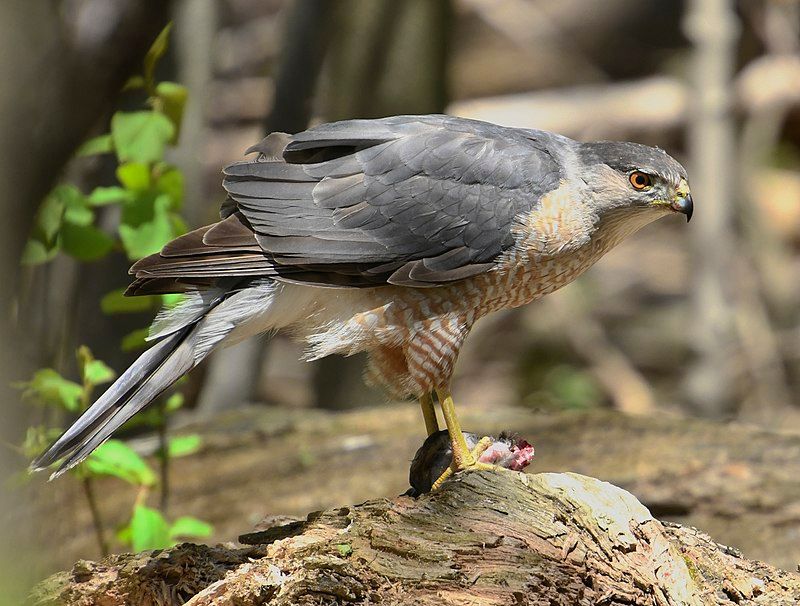
The Cooper’s hawk is a type of hawk that can be found in North America. It is considered to be a medium-sized bird.
This species is native to the continent and is commonly found in various regions ranging from southern Canada all the way down to Mexico. One interesting characteristic of the Cooper’s hawk is its size.
It falls into the category of medium-sized hawks, which means it is neither too big nor too small. This size allows the hawk to adapt and survive in different habitats across North America. The distribution of the Cooper’s hawk is quite extensive.
It can be found in different parts of North America, including southern Canada, the United States, and Mexico.
This wide range of habitats gives the hawk ample opportunities to thrive and establish its presence in various ecosystems. Despite its widespread distribution, the Cooper’s hawk is not evenly distributed throughout its range.
It tends to be more common in certain areas while being less abundant in others. This variation in population density might be influenced by factors such as availability of prey, nesting sites, and overall habitat suitability. The Cooper’s hawk is known for its hunting skills.
It primarily feeds on small to medium-sized birds, which it catches by surprise using its speed and agility. This hawk is well-adapted.
| Kingdom | Animalia |
| Phylum | Chordata |
| Clade | Dinosauria |
| Class | Aves |
| Order | Accipitriformes |
| Family | Accipitridae |
| Genus | Accipiter |
| Species | A. cooperii |
36. Tit
The paragraph introduces three types of birds: tits, chickadees, and titmice. These birds are part of a larger family called Paridae. They are small passerine birds, which means they belong to the order of perching birds.
They are commonly found in the Northern Hemisphere and Africa. In the past, most of these birds were grouped under the genus Parus. Genus is a classification category in biology that groups similar organisms together.
However, there seem to be changes in how these birds are classified. The Paridae family includes various species of tits, chickadees, and titmice. These birds share certain characteristics that make them part of the same family.
They are generally small in size, with compact bodies and short beaks. They are known for their agile movements and ability to cling to branches and feed on insects. Tits, chickadees, and titmice are known for their distinctive calls and songs.
They are often heard chirping and singing in trees and bushes. These birds are also known for their lively and active behavior, constantly flitting around in search of food. The distribution of these birds is mainly concentrated in the Northern Hemisphere and Africa.
| Kingdom | Animalia |
| Phylum | Chordata |
| Clade | Dinosauria |
| Class | Aves |
| Order | Passeriformes |
| Family | Paridae |
37. Tyrant Flycatchers
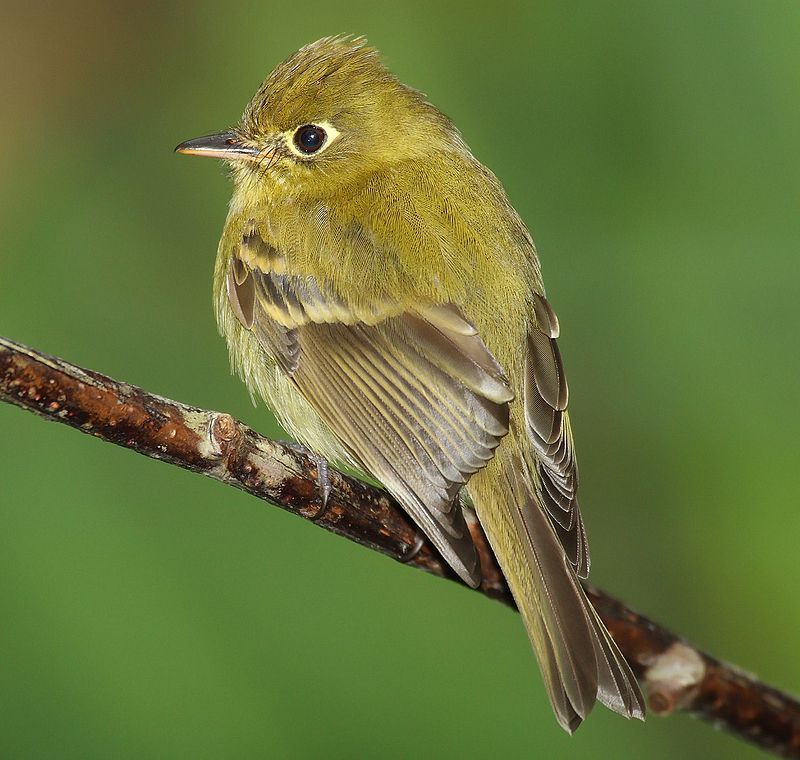
The tyrant flycatchers are a group of birds that can be found in North and South America. They are known as passerine birds because they belong to the order Passeriformes, which includes perching birds. These birds are considered to be the largest family of birds in the world.
In fact, there are more than 400 different species of tyrant flycatchers. This means this family has a great variety, with each species having unique characteristics. Tyrant flycatchers are known for their ability to catch insects on the wing.
Their specialized beak allows them to snatch insects out of the air. This makes them excellent aerial hunters and helps them to survive in their environments. These birds are also known for their distinct calls.
Each species has its own specific call, which helps them communicate with other members of their species.
Some tyrant flycatchers have loud and piercing calls, while others have soft and melodic ones. Tyrant flycatchers are found in a wide range of habitats, including forests, grasslands, and wetlands.
They have adapted to live in various environments and can be found from the Arctic tundra to the tropical rainforests.
| Kingdom | Animalia |
| Phylum | Chordata |
| Clade | Dinosauria |
| Class | Aves |
| Order | Passeriformes |
| Family | Tyrannidae |
38. American Goldfinch
The American goldfinch is a type of bird that is found in North America.
It belongs to the finch family, which is a group of small birds known for their colorful feathers and pleasant songs. This bird is migratory, meaning it travels from one place to another depending on the time of year.
During the breeding season, which is when they mate and lay eggs, the American goldfinch can be found in areas ranging from mid-Alberta in Canada to North Carolina in the United States.
When the weather gets colder, the American Goldfinch migrates to a different region in the winter.
They move from just south of the Canada–United States border and travel all the way down to Mexico.
This helps them find better conditions for survival, as the temperature and food availability change with the seasons. The reason for their migration is mainly related to the availability of food.
During the breeding season, the American goldfinch feeds on insects and seeds from plants like sunflowers and thistles.
These food sources are abundant in the areas where they breed, providing them with the necessary nutrients for reproduction and raising their young. However, these insects and plants may not be readily available in their breeding grounds.
| Kingdom | Animalia |
| Phylum | Chordata |
| Clade | Dinosauria |
| Class | Aves |
| Order | Passeriformes |
| Family | Fringillidae |
| Genus | Spinus |
| Species | S. tristis |
39. Townsend’s Warbler
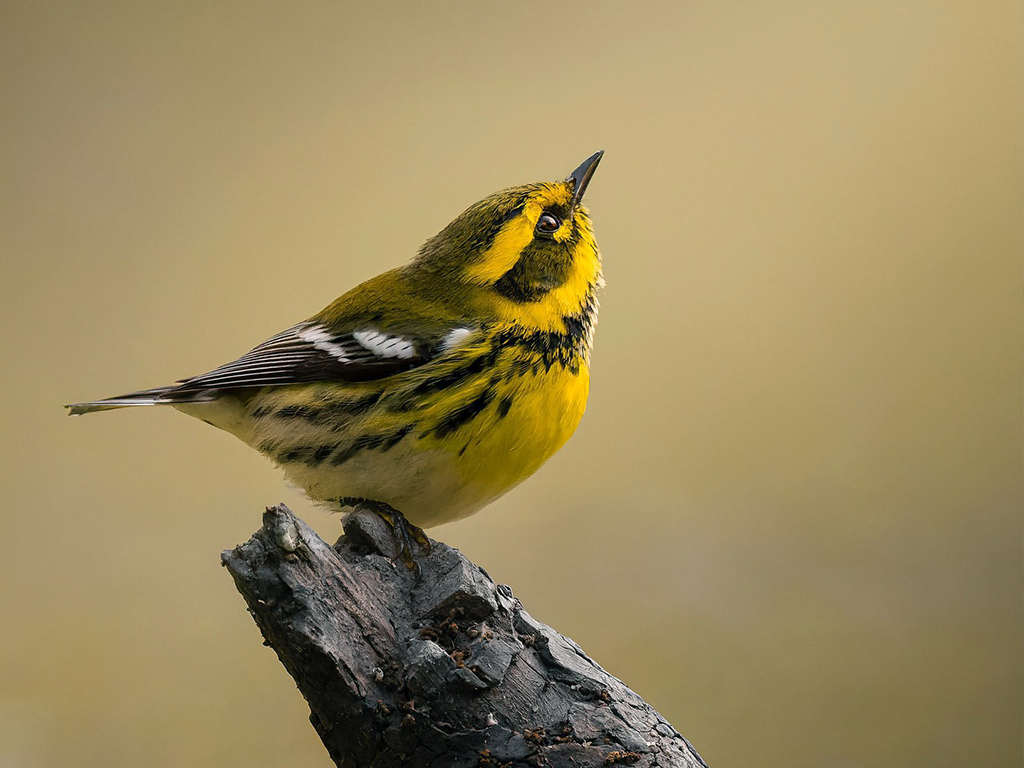
Townsend’s warbler is a small bird belonging to the New World warbler family. This family of birds is known for their beautiful songs and colorful plumage.
The Townsend’s warbler, like other members of its family, is found mainly in North America. This warbler species is named after John Kirk Townsend, a naturalist who explored and studied various species of birds in the 19th century.
The Townsend’s warbler is known for its striking appearance and distinctive features. It has a bright yellow body with black streaks and a black cap on its head.
Its wings also display a combination of black and white feathers. In terms of size, Townsend’s warbler is relatively small, measuring about 4.5 to 5 inches in length.
Despite its small size, it possesses a solid and agile flight, allowing it to navigate through the dense foliage of trees where it usually resides.
The habitat of the Townsend’s warbler includes coniferous forests, especially those found in the western regions of North America.
These forests provide the ideal environment for the warbler’s breeding and nesting activities. The species migrates during the winter to areas further south, such as Mexico and Central America.Like other warblers, Townsend.
| Kingdom | Animalia |
| Phylum | Chordata |
| Clade | Dinosauria |
| Class | Aves |
| Order | Passeriformes |
| Family | Parulidae |
| Genus | Setophaga |
| Species | S. townsendi |
40. Hooded Merganser
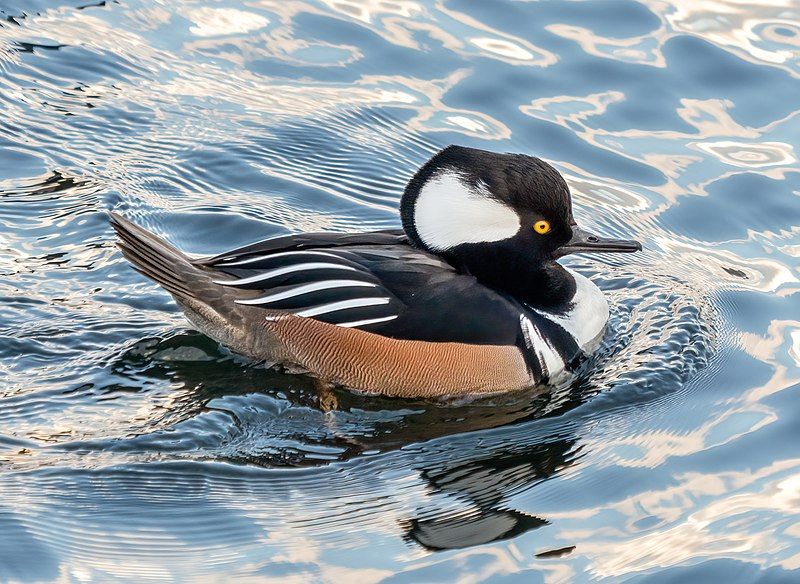
The hooded merganser is a type of duck that likes to eat fish. It belongs to the Anatinae subfamily, which is a group of ducks. This duck is unique because it is the only species in its genus, called Lophodytes.
The word “genus” refers to a group of closely related species—the name of the genus, oocytes, comes from the Greek language. In Greek, “lophos” means “crest,” which refers to the feathers on the top of the duck’s head. These feathers stick up and look like a crest or a tuft.
The word “dutes” means “diver,” which is a bird that can swim underwater to catch food. So, when we put the two Greek words together, we get Lophodytes, which means a diving bird with a crest.
This name perfectly describes the hooded merganser because it has a distinctive crest and it can dive underwater to catch fish. In summary, the hooded merganser is a type of fish-eating duck.
It is the only species in its genus, called Lophodytes, which comes from the Greek words for crest and diver.
| Kingdom | Animalia |
| Phylum | Chordata |
| Clade | Dinosauria |
| Class | Aves |
| Order | Anseriformes |
| Family | Anatidae |
| Genus | Lophodytes |
| Species | L. cucullatus |
41. American Tree Sparrow
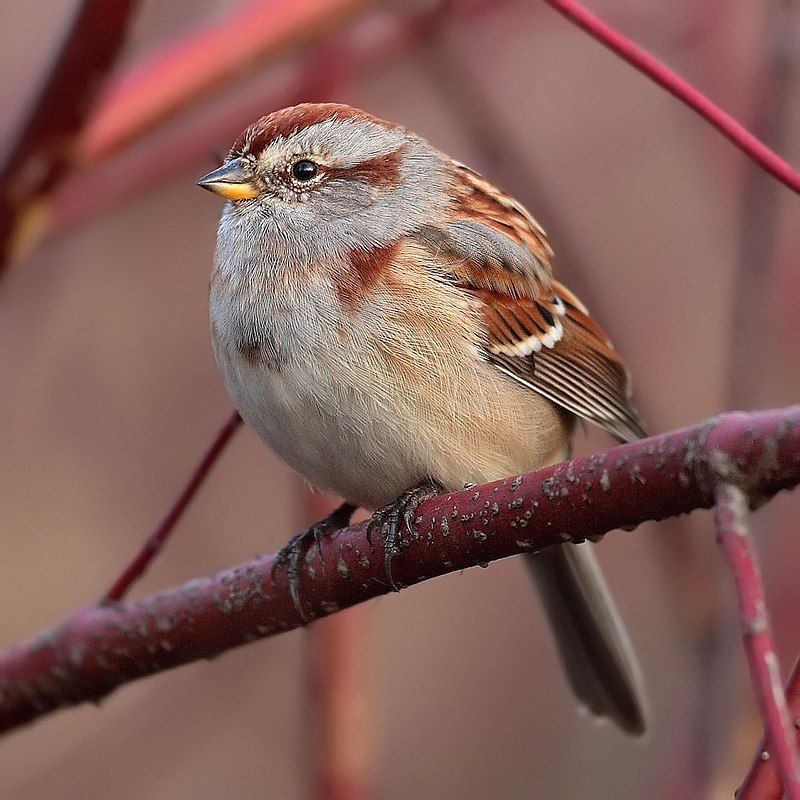
The American tree sparrow is a type of bird that is commonly found in North America. It is also known by another name, which is the winter sparrow.
This bird is medium-sized compared to other sparrows of the New World. The American tree sparrow is easily recognizable due to its distinct physical features. It has a plump body with a rounded head and a short tail. Its beak is cone-shaped and designed for eating seeds.
The bird’s plumage is mostly brown and gray, with a white belly and a chestnut-colored cap on its head. During the winter months, the American tree sparrow migrates from its breeding grounds in the Arctic tundra to more southern regions of North America.
It seeks out habitats such as forests, thickets, and shrubby areas. This bird prefers to perch on branches rather than hopping on the ground like some other species of sparrows. In terms of diet, the American tree sparrow primarily feeds on seeds.
It has a preference for seeds from grasses, weeds, and various plants. It uses its beak to crack open the seeds hard, allowing it to access the nutritious interior. The breeding season for the American tree sparrow occurs during the summer.
| Kingdom | Animalia |
| Phylum | Chordata |
| Clade | Dinosauria |
| Class | Aves |
| Order | Passeriformes |
| Family | Passerellidae |
| Genus | Spizelloides |
| Species | S. arborea |
42. Bufflehead
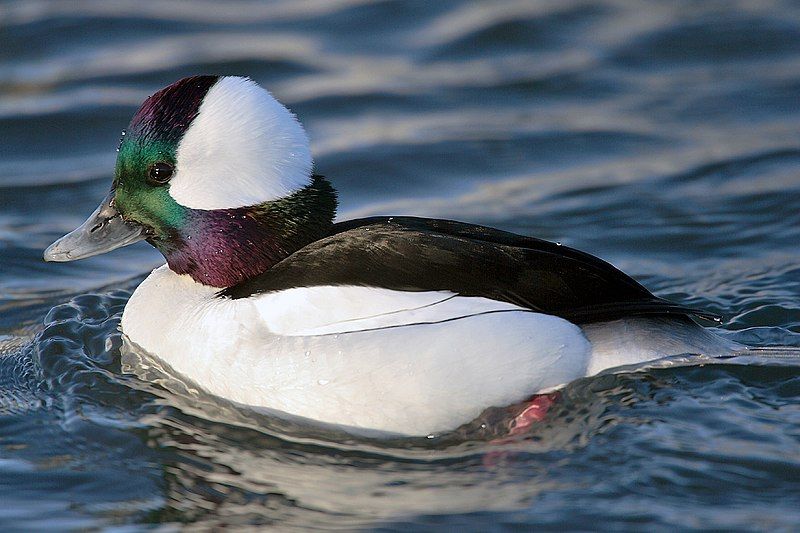
The paragraph discusses the bufflehead, which is a type of small sea duck belonging to the genus Bucephala. This genus also includes other ducks known as goldeneyes.
The bufflehead was first identified and described by Carl Linnaeus, a renowned Swedish scientist, in his influential work called Systema Naturae. Linnaeus published the 10th edition of this book in 1758, where he classified various species of plants and animals.
In this edition, he named the bufflehead as Anas albeola, which is the scientific name for this species.
| Kingdom | Animalia |
| Phylum | Chordata |
| Clade | Dinosauria |
| Class | Aves |
| Order | Anseriformes |
| Family | Anatidae |
| Genus | Bucephala |
| Species | B. albeola |
43. Cardinalidae
Cardinalidae is a family of birds that are found only in the New World. This means that they are native to the Americas and are not found anywhere else in the world. The family is made up of different species, including cardinals, grosbeaks, and buntings.
These birds are all part of the same family because they share similar characteristics and traits. Cardinals are perhaps the most well-known members of the Cardinalidae family. They are known for their vibrant red plumage, which is more prominent in the males than in the females.
Cardinals are often seen in backyards and gardens, where they feed on seeds and insects. They have a distinct crest on their heads, which adds to their unique appearance. Grosbeaks are another type of bird that belongs to the Cardinalidae family.
They are named after their large, thick beaks, which are adapted for cracking open seeds and nuts. Grosbeaks come in various colors, including red, black, and yellow.
They are known for their beautiful songs and can be found in forests and woodlands across the Americas. Buntings are also part of the Cardinalidae family. They are small to medium-sized birds that are known for their colorful plumage.
| Kingdom | Animalia |
| Phylum | Chordata |
| Clade | Dinosauria |
| Class | Aves |
| Order | Passeriformes |
| Family | Cardinalidae |
44. Purple Finch
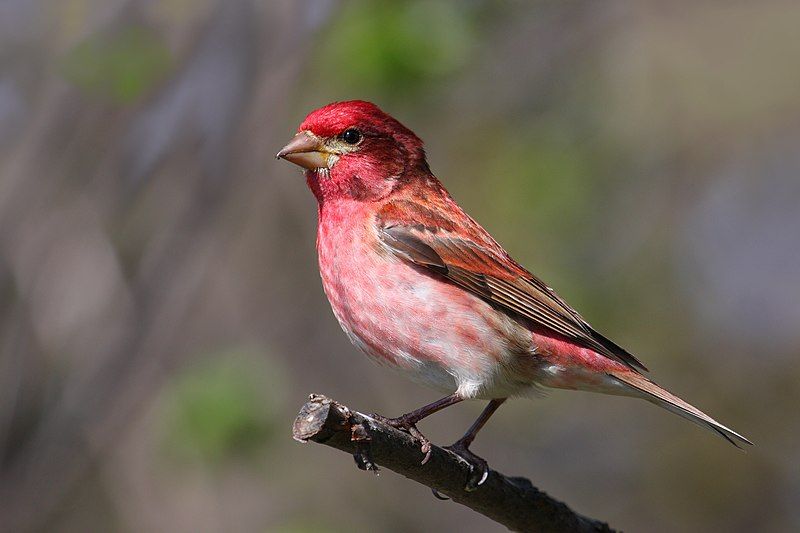
The purple finch is a type of bird. It belongs to the finch family called Fringillidae. This family includes various species of finches. The purple finch is one of them. This bird is found in different parts of North America.
It breeds in the northern United States, laying eggs and raising young there. It also breeds in southern Canada, which is the region located below the northern part of Canada.
Additionally, the bird can be found along the west coast of North America. Breeding refers to the process of reproduction in animals, where they mate and produce offspring. Like purple finch, bluebirds hold nests and lay eggs for breeding.
They take care of their eggs until they hatch, and then they raise their chicks until they are ready to leave the nest. The purple finch is known for its vibrant purple coloration.
Males have a deep red or raspberry-colored plumage with a purple tint, while females have a more subdued plumage with streaks of brown and white.
This difference in appearance between males and females is called sexual dimorphism. In addition to its striking color, the purple finch has a sturdy beak that is well-suited for cracking open seeds.
| Kingdom | Animalia |
| Phylum | Chordata |
| Clade | Dinosauria |
| Class | Aves |
| Order | Passeriformes |
| Family | Fringillidae |
| Genus | Haemorhous |
| Species | H. purpureus |
45. White-Breasted Nuthatch
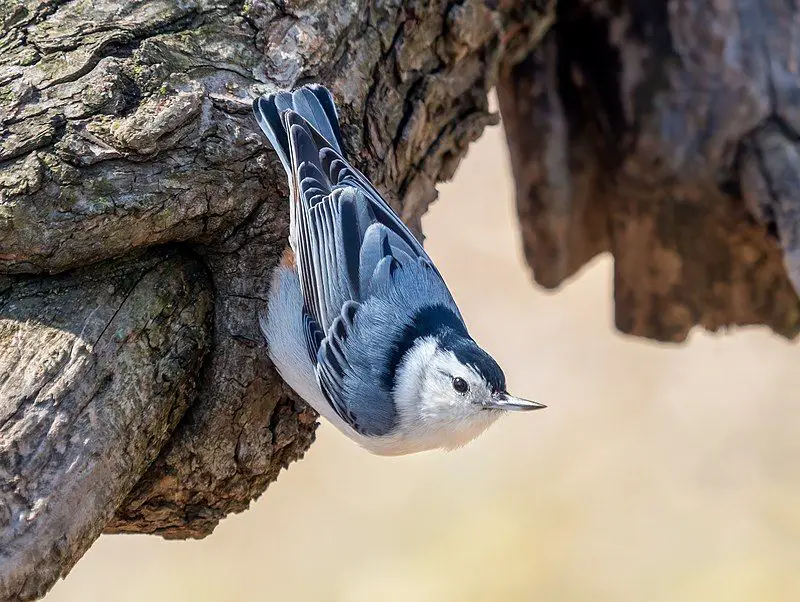
The white-breasted nuthatch is a type of bird that belongs to the nuthatch family called Sittidae.
This family includes various species of nuthatches, but we will focus on the white-breasted nuthatch in this discussion. The white-breasted nuthatch is considered to be a medium-sized bird, measuring around 15.5 cm in length.
This measurement gives us an idea of its size in comparison to other birds. While it may not be the largest bird out there, it is also not the smallest. One interesting feature of the white-breasted nuthatch is its white breast, which gives it its name.
This white coloration on its chest stands out and helps to identify it from other species of nuthatches.
Not all nuthatches have this specific feature, making it unique to the white-breasted nuthatch; as a nuthatch family member, the white-breasted nuthatch shares certain characteristics with other nuthatch species.
For example, nuthatches are known for their ability to climb up and down trees headfirst. This behavior is quite fascinating to observe, as most birds can only move in an upward direction.
| Kingdom | Animalia |
| Phylum | Chordata |
| Clade | Dinosauria |
| Class | Aves |
| Order | Passeriformes |
| Family | Sittidae |
| Genus | Sitta |
| Species | S. carolinensis |
Conclusion
Winter birds in California showcase the state’s rich biodiversity and provide a delightful sight for birdwatchers and nature enthusiasts during the colder months.
The unique combination of the Pacific flyway, mild climate, and diverse habitats attract a wide variety of bird species from north and south.
California offers a remarkable range of winter bird species.
, from waterfowl and shorebirds to raptors and migratory. Additionally, the presence of winter birds serves as a reminder of the importance of preserving and protecting California’s ecosystems and habitats, ensuring the continued survival of these magnificent creatures.
So, whether one is a seasoned birder or simply enjoys the beauty of nature, winter birds in California never fail to captivate with their colors, calls, and remarkable adaptations.